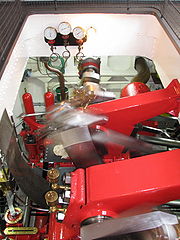Early steam carriage services
More commercially successful for a time than Trevithick’s carriage were the steam carriage services operated in England in the 1830s, principally by Walter Hancock and associates of Sir Goldsworthy Gurney, among others. However, the heavy road tolls imposed by the Turnpike Acts discouraged steam road vehicles and for a short time allowed the continued monopoly of horse traction until railway trunk routes became established in the 1840s and ’50s.
Although engineers developed ingenious steam-powered road vehicles, they did not enjoy the same level of acceptance and expansion as steam power at sea and on the railways in the middle and late 19th century of the “Age of Steam”. Harsh legislation virtually eliminated mechanically propelled vehicles from the roads of Great Britain for 30 years, the Locomotive Act of 1861 imposing restrictive speed limits on “road locomotives” of 5 mph (8 km/h) in towns and cities, and 10 mph (16 km/h) in the country. In 1865 the Locomotives Act of that year (the famous Red Flag Act) further reduced the speed limits to 4 mph (6.4 km/h) in the country and just 2 mph (3.2 km/h) in towns and cities, additionally requiring a man bearing a red flag to precede every vehicle. At the same time, the act gave local authorities the power to specify the hours during which any such vehicle might use the roads. The sole exceptions were street trams which from 1879 onwards were authorised under licence from the Board of Trade.
 In France the situation was radically different from the extent of the 1861 ministerial ruling formally authorising the circulation of steam vehicles on ordinary roads. Whilst this led to considerable technological advances throughout the 1870s and ’80s, steam vehicles nevertheless remained a rarity. To an extent competition from the successful railway network reduced the need for steam vehicles. From the 1860s onwards, attention was turned more to the development of various forms of traction engine which could either be used for stationary work such as sawing wood and threshing, or for transporting outsize loads too voluminous to go by rail. Steam trucks were also developed but their use was generally confined to the local distribution of heavy materials such as coal and building materials from railway stations and ports.
In France the situation was radically different from the extent of the 1861 ministerial ruling formally authorising the circulation of steam vehicles on ordinary roads. Whilst this led to considerable technological advances throughout the 1870s and ’80s, steam vehicles nevertheless remained a rarity. To an extent competition from the successful railway network reduced the need for steam vehicles. From the 1860s onwards, attention was turned more to the development of various forms of traction engine which could either be used for stationary work such as sawing wood and threshing, or for transporting outsize loads too voluminous to go by rail. Steam trucks were also developed but their use was generally confined to the local distribution of heavy materials such as coal and building materials from railway stations and ports.

Hi, this is a comment.
To delete a comment, just log in, and view the posts’ comments, there you will have the option to edit or delete them.